Sinquefield Cup 2017 Round 2: Magnus Carlsen shows he is the boss
The star studded field of the Sinquefield Cup 2017 is treating the crowd to some lively games. In round two Magnus Carlsen beat his World Championship opponent Sergey Karjakin. Wesley So showed a model game on how to punish unconventional opening play. Levon Aronian blundered a piece, handing the game to Caruana on a platter. The other games ended in a draw, but were not without excitement. Let IM V. Saravanan take you through the intricacies of all the battles.
The Sinquefield Cup continues to delight the spectators and chess fans, with its indomitable fighting games and typical drama. The second round too saw three games ending decisively and near-complete effort from all the players.

It was classic Carlsenomics in action at the second round at the Sinquefield Cup! And it was delightful to see the world champion come up with such a strong display of pressure chess against his immediate past challenger, Sergey Karjakin. The game had many ingredients of typical Carlsen ‘water-torture’: an innocuous developing of pieces in the opening, keeping all forces at his disposal ready to spring them into action, looking to expand his influence on the board at the same time making it difficult for the opponent to find any dynamism for his pieces…
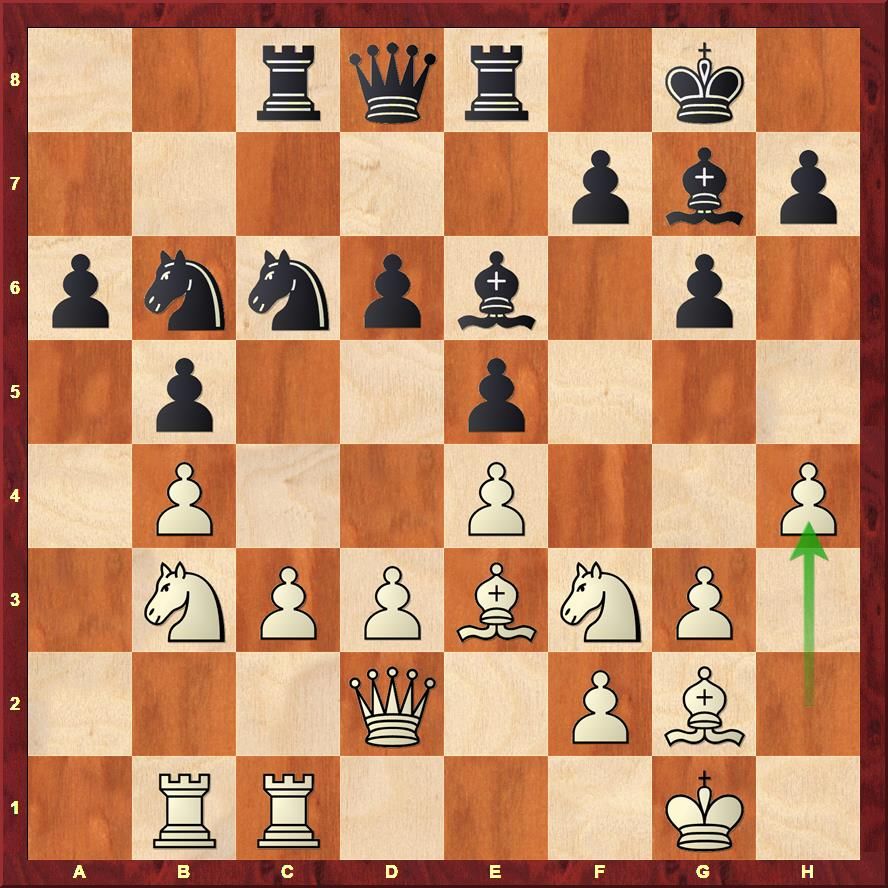

It was all the more impressive as Carlsen managed to bring this treatment to one of his main rivals against whom he fought the World Championship in Nov 2016. “I was just trying to find waiting moves, and find a correct moment to play cxb5 or d4 but really didn’t find anything. Then I started to gamble with this whole operation on the kingside”, said Carlsen about the middlegame phase.
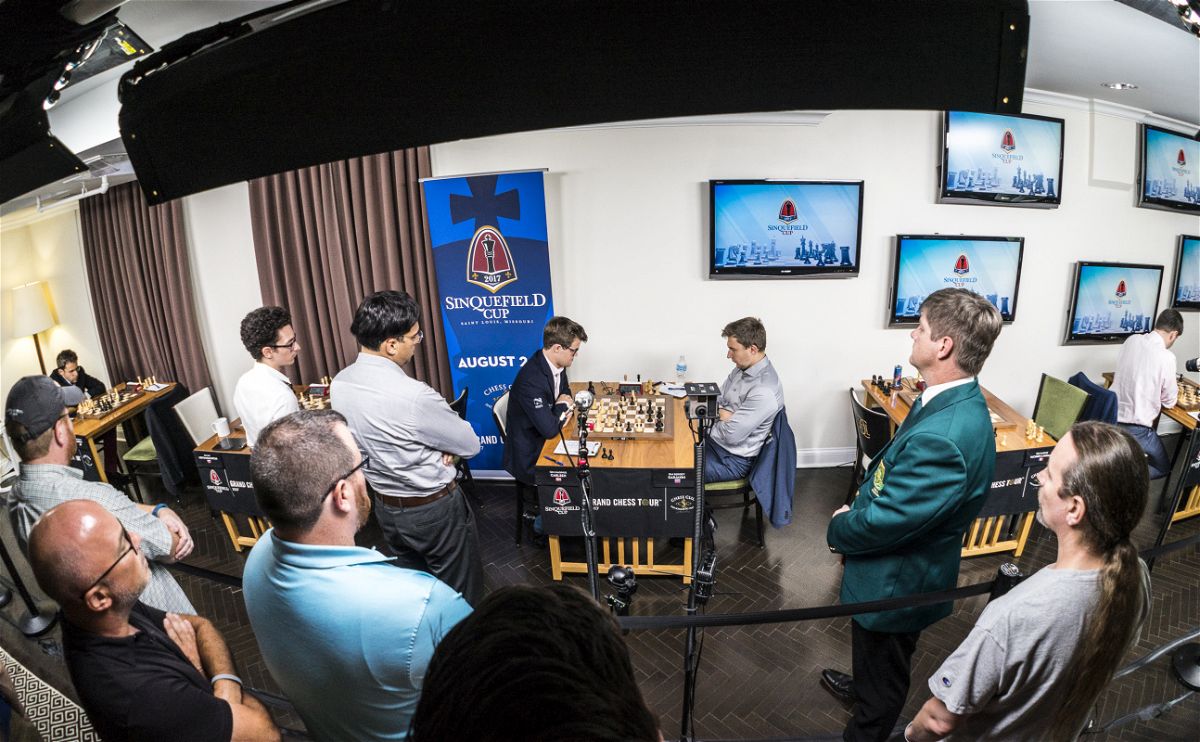
And typically, things reached a crescendo when Carlsen played 26.Rc6, bringing about a position where objectively Black was still doing fine. But he had strategic weaknesses which he had no choice but pushed to defend properly. “Oof! I don’t know what he intends to play against 31.Rc5 - it’s getting unpleasant. Without thinking very much about (the position), I would rather be White (here). But, Sergey is the best defender in the world!” quipped Vishy Anand, when asked for his opinion about the position.

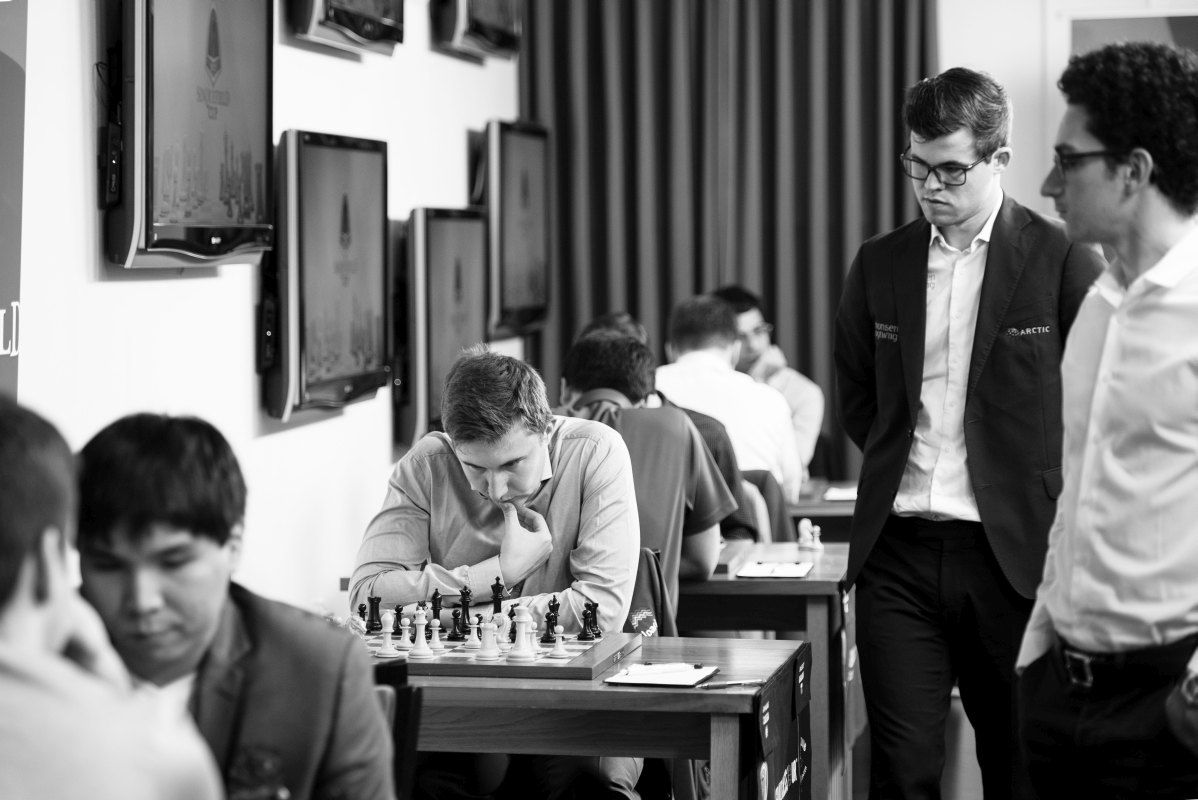
But even such established defensive skills couldn’t help Karjakin much on this occasion, as his position steadily went downhill under the pressure of the clock, resulting in a well-deserved victory for the world champion. “At some point I played badly - probably my biggest mistake was 31...Rc8, but I underestimated his play with f4-f5, but probably I was already lost”, opined Karjakin about his own play.
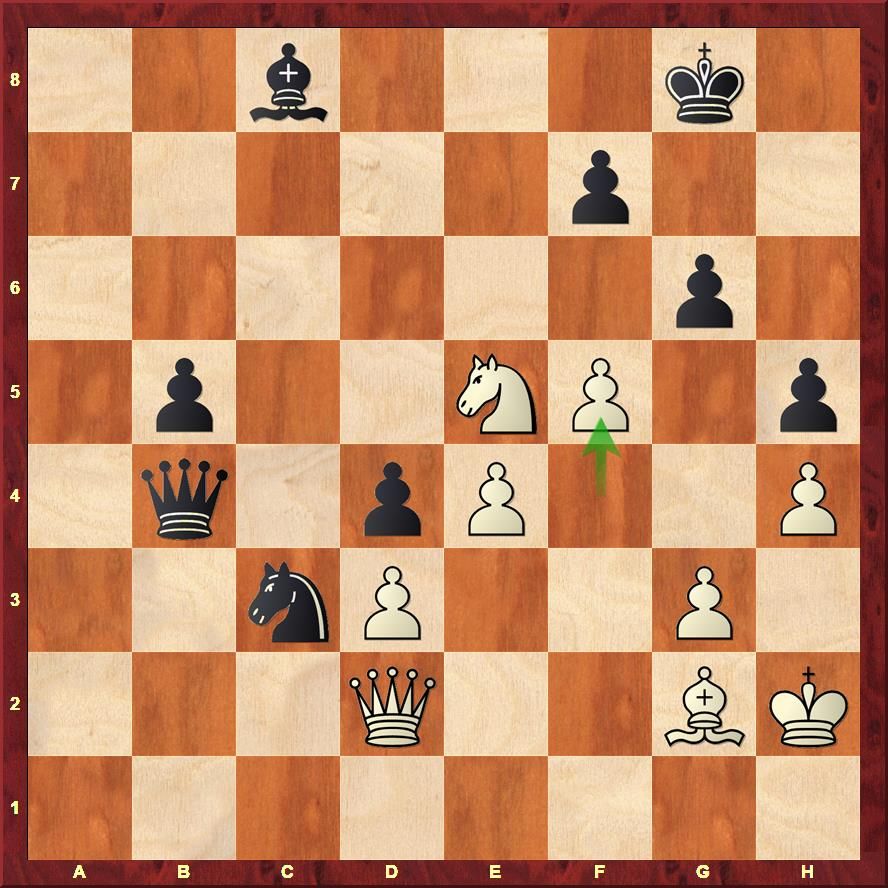

[Site "Saint Louis"]
[Date "2017.08.03"]
[Round "2"]
[White "Carlsen, Magnus"]
[Black "Karjakin, Sergey"]
[Result "1-0"]
[ECO "A05"]
[WhiteElo "2822"]
[BlackElo "2773"]
[Annotator "Saravanan,V"]
[PlyCount "83"]
[EventDate "2017.??.??"]
[EventCountry "USA"]
[SourceTitle "playchess.com"]
[Source "ChessBase"]
[SourceQuality "1"]
9. b4 {Steering clear of any popular theory, Carlsen strives to enter a
strategic position where he can try to pressurise his opponent incrementally}
a6 10. Nbd2 b5 11. Rb1 Nd7 12. Nb3 cxb4 13. axb4 Nb6 14. Be3 Be6 15. Qd2 Rc8
16. Rfc1 {Bringing all his pieces into play, and looking for ways to further
his play} Re8 17. h4 {Typical Carlsen! More than trying to understand White's
objective behind the move, it is useful to think how Black should respond here}
Na4 {It is easy to question this move, as it allows White to expand c3-c4, but
objectively it is still not a sin to carry on with this} (17... Bg4 {could
have been the way to play without giving any concessions for White here}) 18.
c4 h5 {But this is a small concession, more of a weakening on the Kingside
than trying to stop White from grabbing space on the kingside} (18... Bg4 {
was called for, aiming to maintain the equilibrium}) 19. Kh2 Bg4 20. cxb5 axb5
21. Na5 Nd4 22. Rxc8 Qxc8 23. Rc1 Qd7 24. Nxd4 exd4 25. Bh6 Bh8 26. Rc6 {
Objectively, Black is still doing fine here, but he is now pushed to defend
precisely. While Black has strategic weaknesses which he has no choice but to
defend with pieces, it is difficult for him to find any dynamic way to play.
Classic Carlsenomics!} Nc3 $2 {That moment when Black becomes pressurised to
'do something' on the board rather than to wait for White's assaults and
defend them} (26... Rc8 {Inserting of this move was very important for Black's
defence} 27. Ra6 Nc3 28. Bf4 Be5 {The difference here is that, White cannot
proceed as he did in the game, due to Black's counter play} 29. f3 Be6 30. Bxe5
dxe5 31. f4 exf4 32. Qxf4 Nd1 $1 {[%cal Gd1e3] The resource which will save
the day for Black - the position still remains tense but Black has counterplay
here}) 27. f3 Be6 28. Bf4 Be5 29. Bxe5 dxe5 30. f4 {Carlsen has got a tangible
plan to push here, and to complicate things, Karjakin was under pressure from
the clock too} Qe7 31. Rc5 Rc8 32. Rxc8+ Bxc8 33. Nc6 Qd6 34. Nxe5 Qxb4 35. f5
$1 $16 {The breakthrough. Carlsen finishes off the game without much
difficulty from hereon} Qd6 36. Nf3 gxf5 37. Qg5+ Kh7 38. e5 Qg6 39. Qd8 Be6
40. Ng5+ Kg7 41. Qxd4 Na4 42. Nh3 1-0
But the other end of the spectrum we had Ian Nepomniachtchi, who handled a chaotic Symmetrical English in an original and confident way, but paid the price of playing fast.

“The opening was more or less good for me. But I managed to blunder in one (move) with 17.f4, after which it was basically over. Maybe, I am not (concentrating) well, but far off my - not even best but even - decent condition”, Nepo after the game. Wesley So had no trouble in converting his advantage, and curiously raised his score against Nepo to an impressive 5 - 0!


[Site "Saint Louis"]
[Date "2017.08.03"]
[Round "2"]
[White "Nepomniachtchi, Ian"]
[Black "So, Wesley"]
[Result "0-1"]
[ECO "A10"]
[WhiteElo "2751"]
[BlackElo "2810"]
[Annotator "Saravanan,V"]
[PlyCount "78"]
[EventDate "2017.??.??"]
[EventCountry "USA"]
[SourceTitle "playchess.com"]
[Source "ChessBase"]
[SourceQuality "1"]
completely original concept of opening play} Nf6 5. Bf4 Nc6 6. Qd2 d6 7. e4 Bg7
8. Bd3 Ne5 9. Nge2 {Nepo had planned for this scheme of development, and
seemed to be quite content with the position after the opening} Nh5 10. Be3 Ng4
11. Bg5 h6 12. Bh4 g5 13. Bg3 Be6 14. h3 Ne5 15. Bxe5 {Highly committal and
original, but Nepo had his logical behind the operation} Bxe5 16. g3 Qa5 {
So took a whole 20 minutes to decide on this move} 17. f4 $2 {Played in just
under two minutes! A blunder in one, as Nepo claimed after the game, and he
was clearly right in his self-criticism. Somewhere in his calculations, he had
'missed' the pawn at g3 due to which White has to capture on c3 with his pawn
here, after which White's pawn structure is seriously compromised} (17. Rb1 {
"Now White is clearly better because Black's knight on h5 is slightly out of
play," was Nepo's optimistic take on the position here}) 17... Bxc3 18. bxc3
Qc7 $17 {Black is completely better here, and for a player in the class of So,
the rest of the game was almost copy-book play} 19. fxg5 hxg5 20. Qxg5 Bxc4 21.
Bxc4 Qxc4 22. Qd5 Qxd5 23. exd5 Rc8 24. Rb1 b6 25. Rb3 Nf6 26. Ra3 a5 27. Nf4
Rg8 28. c4 Rxc4 29. Ke2 Ne4 30. g4 f5 31. Rg1 fxg4 32. hxg4 Nc3+ 33. Kd3 Rxf4
34. Rxc3 Rgxg4 35. Rc8+ Kf7 36. Rb1 Rd4+ 37. Ke3 Rxd5 38. Rxb6 Rg2 39. a4 Rg4
0-1
But totally inexplicable was the play by someone who delighted everyone with his free spirit, boldness and imagination in the first round. “Levon didn’t seem himself throughout the game”, opined Carlsen, and we couldn’t agree more. Starting with an insipid Be2, Aronian’s handling of the opening was puzzling, especially as the Queen’s Gambit Accepted is part of Caruana’s repertoire. Even then, Aronian’s play seemed a notch below par throughout the game and a horrendous blunder with 33.Ke2?? brought about a painful defeat.
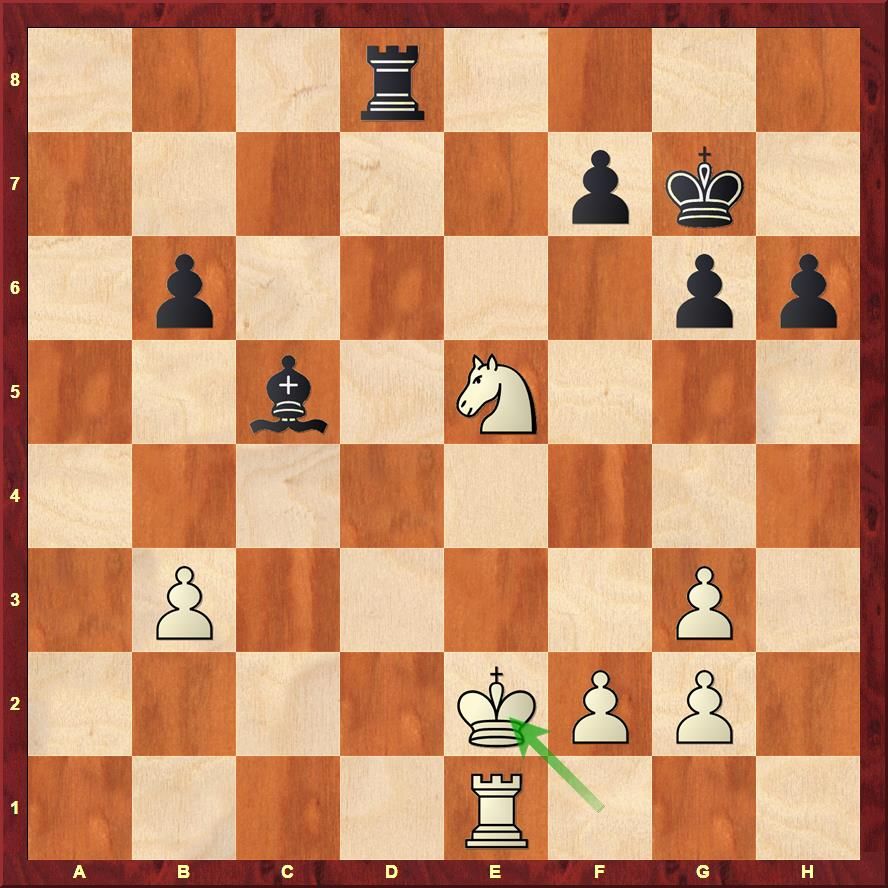

[Site "Saint Louis"]
[Date "2017.08.03"]
[Round "2"]
[White "Aronian, Levon"]
[Black "Caruana, Fabiano"]
[Result "0-1"]
[ECO "D27"]
[WhiteElo "2799"]
[BlackElo "2807"]
[Annotator "Saravanan,V"]
[PlyCount "220"]
[EventDate "2017.??.??"]
[EventCountry "USA"]
[SourceTitle "playchess.com"]
[Source "ChessBase"]
[SourceQuality "1"]
1. d4 d5 2. Nf3 Nf6 3. c4 dxc4 4. e3 e6 5. Bxc4 c5 6. O-O a6 7. Be2 {Hardly a
move which can pose any opening challenges for Black} cxd4 8. exd4 Nc6 9. Nc3
Be7 10. Be3 {White sets himself very modest aims from the opening, and has
entered a variation of the Alapin Sicilian with a move less!} Ng4 11. Bf4 Nf6
12. Rc1 O-O 13. Na4 Nd5 14. Bg3 Bd6 15. Bd3 Nce7 16. Qb3 b6 17. Be4 Rb8 18.
Rfe1 Bb7 19. Nc3 (19. Ne5 {White could simply play in a typical way with an
isolated pawn here}) 19... Nxc3 20. Bxb7 Nxa2 $1 {A nice intermezzo} 21. Qxa2
Rxb7 22. Qxa6 Rc7 {Slowly and surely, Black has built a steady position and
has a slight edge here due to White's isolted d4-pawn} 23. b3 Nf5 (23... Bxg3
24. hxg3 Qc8 {was expected}) 24. Rxc7 Qxc7 25. Qb5 h6 26. d5 {White should
have been happy to get rid of his isolated pawn, and his defensive chances get
a little better now} exd5 27. Qxd5 Nxg3 28. hxg3 Rd8 {Black has a niggling
edge here, mainly by having a Bishop against Knight in an open position, but
due to very less material being present on the board, he can be optimistic
about holding his own here} 29. Qb5 g6 30. Ne5 $6 (30. Re8+ Rxe8 31. Qxe8+ Kg7
32. Qe3 {was obviously seemed a preferred way to defend}) 30... Qc5 31. Qxc5
Bxc5 {A classic case of a Rook and Bishop against a Rook and Knight, and Black
could look forward to invading the White camp} 32. Kf1 Kg7 33. Ke2 $4 {But
this is inexplicable - a clear blunder by Aronian, who hardly took any time
for this move and thus paid the price for the momentary loss of concentration}
(33. f4 f6 34. Nc6 Rd3 35. b4 {and White still has to solve his problems})
33... Bb4 34. Rc1 Re8 35. f4 f6 36. Rc7+ Kh8 37. Rc6 fxe5 38. Rxb6 exf4+ 39.
Kf3 Re3+ 40. Kxf4 Bd2 {Funnily, starting from here, Caruana misses ways to end
the game quickly hereon} (40... g5+ $1 41. Kxe3 Bc5+ 42. Ke4 Bxb6 $19) 41. Rxg6
Kh7 42. Kf5 Rxb3 (42... Re5+ 43. Kxe5 Kxg6 {was a way to win too, thanks to
White's pawn structure offering a study-like win in this position}) 43. Rd6 Bg5
{White's position cannot be called as a fortress but Black nevertheless has a
win in the long run} 44. Rd7+ Kg8 45. Kg4 Bf6 46. Kf5 Bg7 47. g4 Rb2 48. g3
Rb5+ 49. Ke4 Bf6 50. Rd3 Rb4+ 51. Kf3 Bg5 52. Rd5 Rb3+ 53. Kg2 Kf7 54. Rd6 Ke7
55. Rc6 Rd3 56. Ra6 Rd6 {The point - exchange of the rooks brings about a
study-like win} 57. Ra3 (57. Rxd6 Kxd6 58. Kf3 Ke5 59. Kg2 Ke4 60. Kf2 Kd3 61.
Kf3 Be3 62. Kg2 Ke2 63. Kh2 Kf1 64. Kh1 Bg1 $1 {and Black wins}) 57... Ke6 58.
Kf3 Ke5 59. Ra5+ Rd5 60. Ra3 Kd4 61. Ra4+ Kd3 62. Ra3+ Kd2 63. Ra1 Rc5 64. Kf2
Rc2 65. Rb1 Bf6 66. Kg2 Ke3+ 67. Kh3 Kf2 68. Rb5 Re2 69. Rb6 (69. g5 {There
were some questions about the resultant position being a win, but a similar
story developed in the game too}) 69... Bg5 70. Rb5 Bd2 71. Kh2 Kf1+ 72. Kh1
Re4 73. Rf5+ Ke2 74. Kg2 Rxg4 {In the resultant endgame, Black should only be
careful not to exchange his Rook} 75. Rf2+ Kd3 76. Rf6 Rd4 77. Rf1 Ke4 78. Rf8
Bg5 79. Rf1 Be3 80. Rf8 Rd2+ 81. Kh3 Bg1 82. Kg4 Ke5 83. Rf5+ Ke6 84. Rf1 Bd4
85. Rh1 Bg7 86. Kf3 Kf5 87. Rh5+ Kg6 88. Rb5 Rd3+ 89. Kf4 Bf8 90. Rb6+ Bd6+ 91.
Ke4 Rd1 92. Kf3 Kf5 93. Rb5+ Be5 94. Rb6 h5 95. Rh6 Kg5 96. Re6 Bd6 97. Re8 Rc1
98. Re6 Rd1 99. Re8 Rg1 100. Kf2 Rc1 101. Kf3 Kf5 {Finally, Black creates a
clever web here and White cannot escape} 102. Re3 Bc5 103. Rd3 Ke5 104. Rd2 (
104. Rb3 Rc2 {[The point - White King is in a serious mating net} 105. g4 h4)
104... Rc3+ 105. Kg2 Ke6 106. Kh3 Bd6 107. Kh4 Bxg3+ 108. Kxh5 Kf5 $3 {The
importance of knowing your basics! This particular Rook+Bishop vs Rook is a
simple win here} 109. Rd5+ Be5 110. Kh4 Rc4+ (110... Rc4+ 111. Kh3 (111. Kh5
Rc2 $19) 111... Rc2 $19) 0-1
Nakamura - Vachier-Lagrave was a triumph for Black’s opening preparation, and careful play by both sides brought about a draw in 33 measured moves.
[Site "Saint Louis"]
[Date "2017.08.03"]
[Round "2"]
[White "Nakamura, Hikaru"]
[Black "Vachier-Lagrave, Maxime"]
[Result "1/2-1/2"]
[ECO "B90"]
[WhiteElo "2792"]
[BlackElo "2789"]
[PlyCount "65"]
[EventDate "2017.??.??"]
[EventCountry "USA"]
[SourceTitle "playchess.com"]
[Source "ChessBase"]
[SourceQuality "1"]
Nbd7 9. Bg2 b5 10. Nd5 Nxd5 11. Qxd5 Qc7 12. Be3 Bb7 13. Qd2 Rc8 14. Nc3 Nb6
15. Bxb6 Qxb6 16. a4 Be7 17. axb5 axb5 18. h4 O-O 19. O-O Rc4 20. b3 Rc7 21.
Nd1 Qd4 22. Qa5 Qc5 23. Ne3 Ra8 24. Qd2 g6 25. Rxa8+ Bxa8 26. Ra1 Ra7 27. Ra5
Qb6 28. Rxa7 Qxa7 29. Qc3 Qb8 30. Qb4 Bc6 31. c4 Kf8 32. Nd5 Bxd5 33. cxd5
1/2-1/2
Vishy Anand did his favourite act of giving up his Bishop for the opponent’s Knight. He did it even better by doing it TWICE! However, he got rid of one of White’s Bishops too and sounded confident in defending the resultant position.


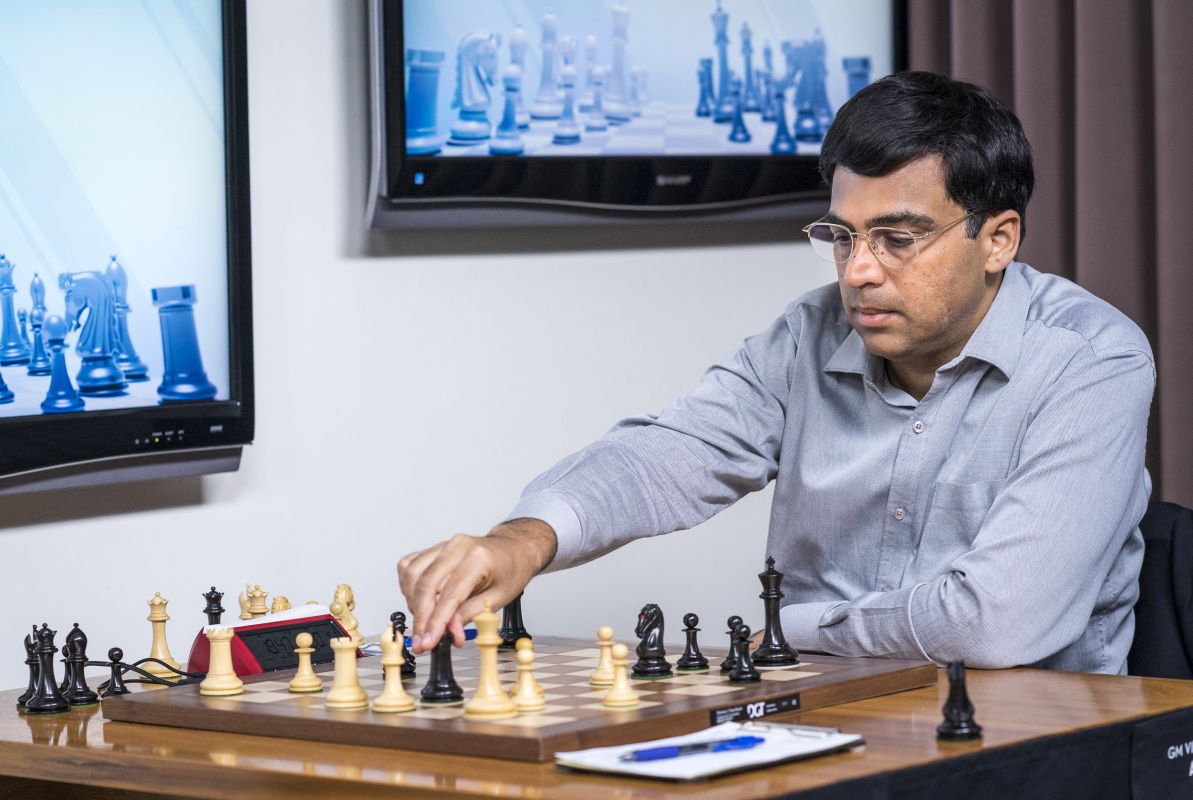
[Site "Saint Louis"]
[Date "2017.08.03"]
[Round "2"]
[White "Svidler, Peter"]
[Black "Anand, Viswanathan"]
[Result "1/2-1/2"]
[ECO "A35"]
[WhiteElo "2751"]
[BlackElo "2783"]
[Annotator "Saravanan,V"]
[PlyCount "61"]
[EventDate "2017.??.??"]
[EventCountry "USA"]
[SourceTitle "playchess.com"]
[Source "ChessBase"]
[SourceQuality "1"]
Nxd4 Bd7 9. O-O Bd6 10. Nf3 a6 11. Ba4 Be6 12. Ne2 O-O 13. Nf4 Bxf4 {Of
course! Anand should have been quite pleased with himself to take upon this
favourite way of conducting the game} 14. exf4 b5 15. Bb3 Bg4 16. h3 (16. Be3
d4) 16... Bxf3 17. Qxf3 Nd4 18. Qd3 Nxb3 19. axb3 d4 {Anand was quite
confident of holding his own here, even though White has a Bishop against a
Knight in an open position} 20. Bd2 (20. Rd1 Re8 21. Qxd4 $4 Re1+ 22. Kh2 Rxd1)
20... Re8 21. Rfd1 Qd5 22. Ba5 h6 {This looked like a stretch} (22... Re4 23.
f3 Rxf4 24. Bc7 Rf5 25. Qxd4 h6 {seemed like a better way to play, as White
still has doubled pawns on the queenside to take care}) 23. Qxd4 Qxb3 24. f5 (
24. Bc3 {might have posed more problems for Black}) 24... Re4 25. Qc3 Qxc3 26.
Bxc3 b4 27. Be1 a5 28. f3 Re2 29. Bxb4 Rxb2 30. Bxa5 Rb5 31. Rd8+ 1/2-1/2
The following curious exchange took place in the post-game chat:
Maurice Ashley: I have seen you doing it often, in terms of bishop trade for knights. It doesn’t seem as though you prefer the knights to the bishops! (Anand starts chuckling) Is that true?
Anand: (with a straight face) Quite a few people have said that of me! Yeah, I think it is true. Quite a few people have made that observation, and even I have noticed that more often than not my bishops are gone but my knights are still there!
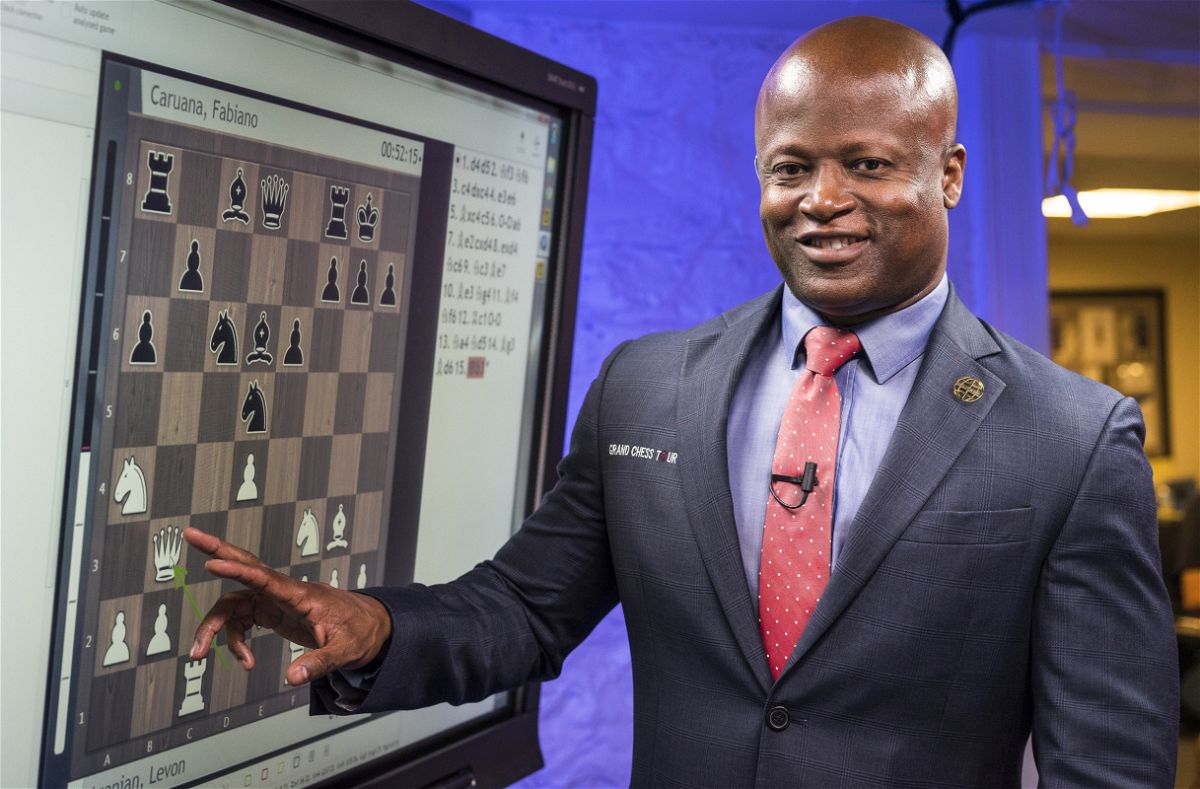
Crosstable after round two:
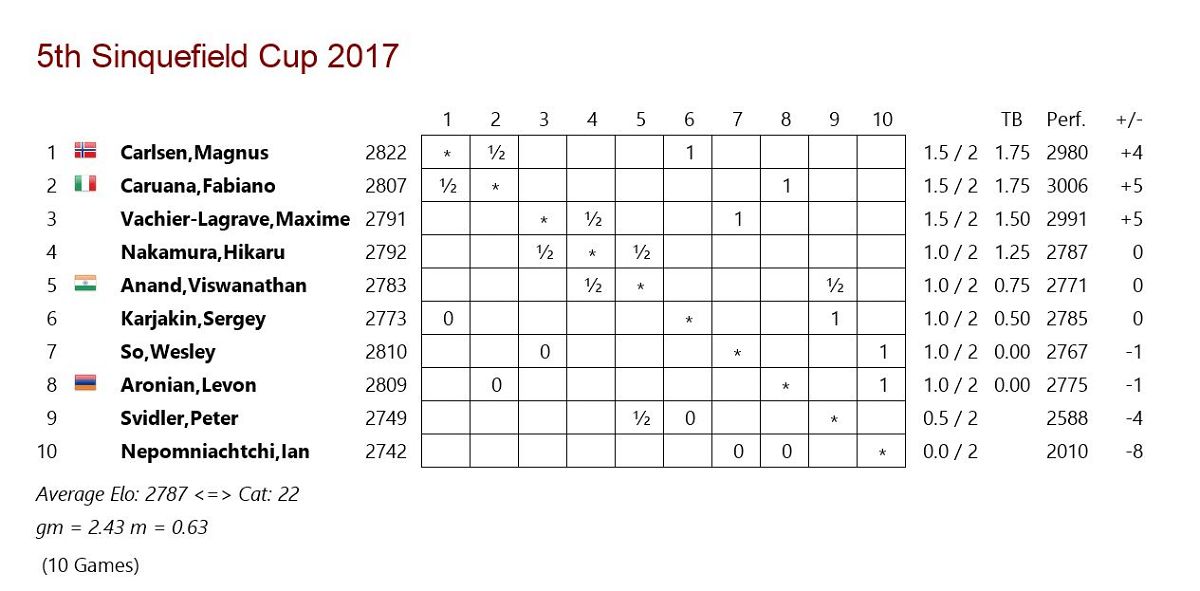
About the Author:

Saravanan Venkatachalam is an International Master and has been an active chess player in the Indian circuit, and has been consistently writing on chess since late 1980s. He turned complete chess professional in 2012, actively playing and being a second and a trainer to a handful of Indian players. He reports on chess tournaments, occasionally being a correspondent to national newspapers and news channels. Apart from chess, he is also interested in Tamil and English literature, music and photography.
Coverage on Firstpost
Firstpost and ChessBase India have collaborated to bring you extensive and detailed coverage of the chess scene in India and internationally.
The Sinquefield Cup and Saint Louis Rapid and Blitz is being extensively by Venkatachalam Saravanan.
Curtain Raiser: Viswanathan Anand faces acid test at the star-studded Sinquefield Cup
Round one: Viswanathan Anand draws first round game against Hikaru Nakamura of United States
Viswanathan Anand impresses despite draw with Peter Svider in second round

